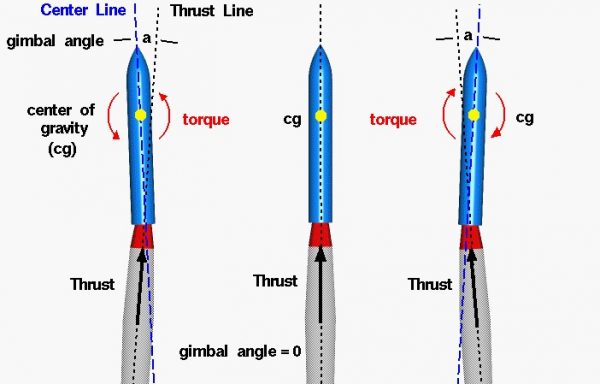Gimbaled Thrust Interactive

Rocket Flight
An important aspect of rocket flight is stability and control of the rocket. Model rockets, stomp rockets, and bottle rockets all use aerodynamic forces to provide some measure of flight stability. But these types of toy rockets do not have any system for flight control. In order to successfully complete its mission, a full-scale rocket is designed with systems for both stability and control. The Guidance system usually includes sophisticated sensors and computers to detect the orientation, location, and speed of the rocket.
Rocket Systems
To maneuver the rocket in flight, several different systems can be used. Early rockets, and some air-to-air missiles, use movable aerodynamic surfaces like the elevators on an airplane. Of course, this system only works on rockets which remain in the atmosphere. Later rockets designed to exit the atmosphere used small vanes in the nozzle exhaust to vector the thrust. Most modern rockets, like the Space Shuttle and the Saturn V moon rockets, use a system called gimbaled thrust.
Gimbaled Thrust System
In a gimbaled thrust system, the exhaust nozzle of the rocket can be swiveled from side to side. As the nozzle is moved, the direction of the thrust is changed relative to the center of gravity of the rocket. On the figure at the top, we show three cases. The middle rocket shows the “normal” flight configuration in which the direction of thrust is along the center line of the rocket and through the center of gravity of the rocket. On the rocket at the left, the nozzle has been deflected to the left and the thrust line is now inclined to the rocket center line at an angle a called the gimbal angle. Since the thrust no longer passes through the center of gravity, a torque is generated about the center of gravity and the nose of the rocket turns to the left. If the nozzle is gimbaled back along the center line, the rocket will move to the left. On the rocket at the right, the nozzle has been deflected to the right and the nose is moved to the right.
Computer Animation
Here is a computer animation of the motion of the rocket as the nozzle is gimbaled:

You can also use this JavaScript program to investigate the motion of a rocket as the nozzle is gimbaled:
Please note: the simulation below is best viewed on a desktop computer. It may take a few minutes for the simulation to load.
